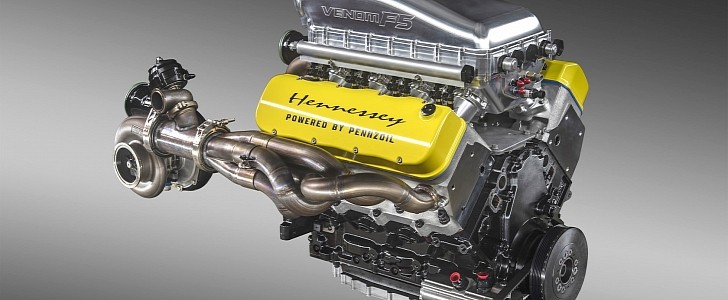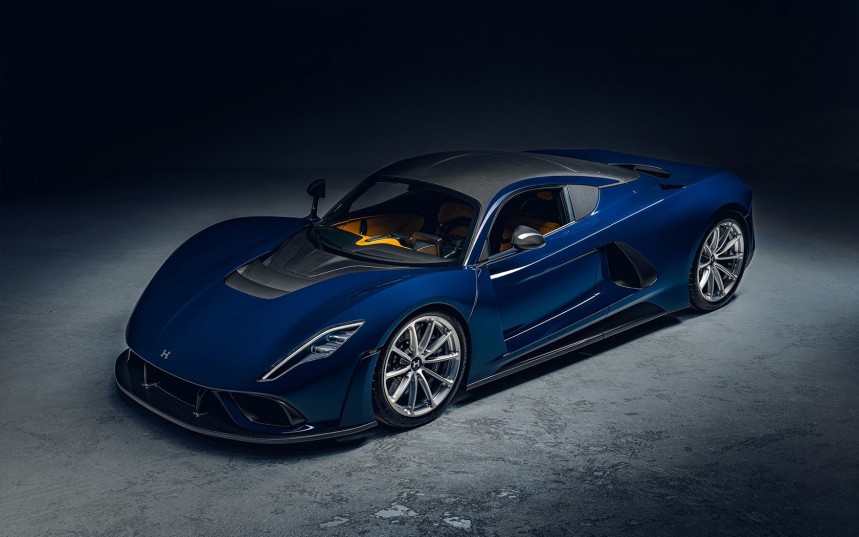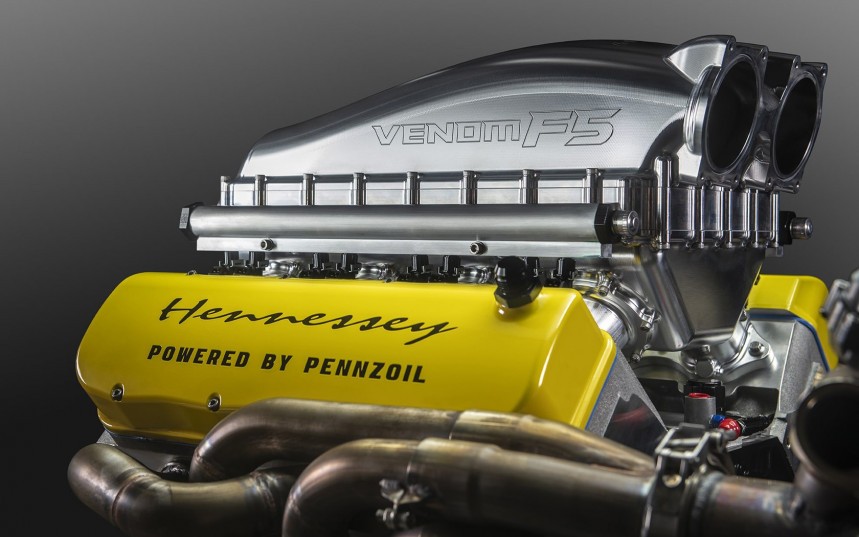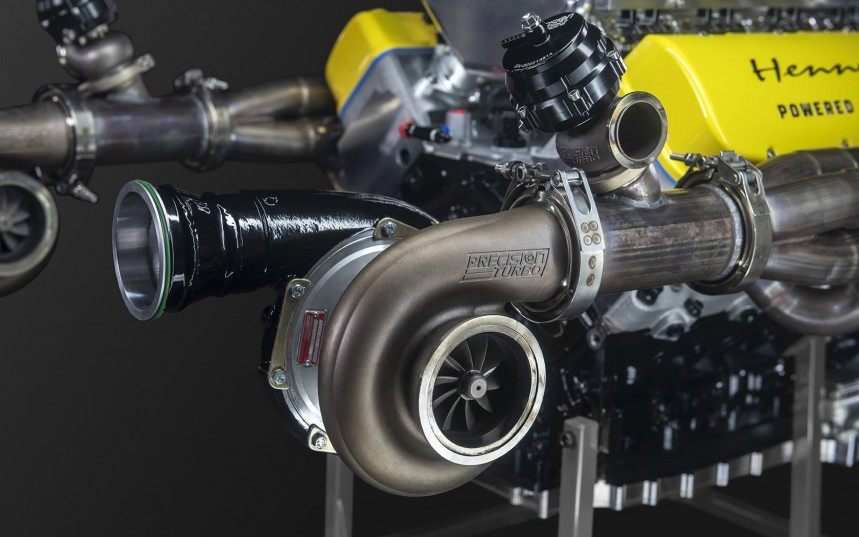The American tuner has made a name for itself by transforming regular vehicles into high-performance works of automotive art. Additionally, it has also been busy developing one of the fastest road-legal hypercars ever made, the Venom F5, which is powered by a mind-blowing bespoke twin-turbo V8 that spits out no less than 1,817 horsepower.
One of Hennessey’s most successful vehicles was the Venom GT, a modified Lotus Exige powered by a beefed-up version of GM’s LS7 small-block V8 that produces 1,244 hp.
It set a Guinness World Record for the fastest road-legal car from 0–186 mph (0–300 km/h) in 2013, with an average acceleration time of 13.63 seconds.
Many other epic projects followed, like the Exorcist or Mammoth, but just like the Venom GT, they are all based on existing performance vehicles.
However, in 2017 at the SEMA Show in Las Vegas, the company revealed an exterior mock-up for their first proprietary vehicle, the Venom F5, which aims to be the fastest production vehicle ever built.
They also established a Special Vehicles division, which would handle all aspects of development for the new hypercar. Among those tasks, one of the most challenging was building a completely new engine that would deliver unprecedented power without the use of an electric drive.
Taking advantage of the experience gained over the last three decades, the company built a mind-blowing V8 that is based on the same iconic GM small block engine family as the Venom GT’s unit.
Nicknamed ‘Fury,’ the hand-built powerplant features an all-new cast-iron block and aluminum cylinder heads with canted titanium intake valves and Inconel exhaust valves with dual springs.
It has the same 104.8 mm (4.1 inches) cylinder bore as the LS7 it is based on, but engineers have reduced the piston stroke to 95.25 mm (3.75 inches), increasing the oversquare ratio to enable an 8,200 rpm redline. They also added a dry-sump system to ensure flawless lubrication at mind-blowing speeds.
Compared to the unit used in the Venom GT, it has a smaller 6.6-liter displacement, which is compensated by pumping more air into the unit using a pair of ceramic-coated Precision turbochargers with 76 mm (2.9-inches) billet aluminum compressor wheels.
They deliver 23 psi (1.5-bar) of air into the two throttle bodies that are mounted to a billet-aluminum intake manifold. It is then pressed down through a water-cooled intercooler bolted between the intake chamber and the lower runners.
All these heavy-duty modifications enable the Fury to produce 1,817 hp (1,842 PS; 1,355 kW) at 8,000 rpm and an equally impressive 1,193 lb-ft (1,617 Nm) or torque around 5,000 rpm. This gives the Venom F5 an astonishing power-to-weight ratio of 1.34 hp/kg.
Customers will be able to choose between two transmission options, a CIMA 7-speed single-clutch automated manual with paddle-shifters or a classic six-speed manual.
Hennessey has recently announced that a production version of the Venom F5 will attempt to exceed 500 kph (311 mph) on a two-way validated speed run. Although the company has not specifically mentioned this, it will most likely go after the SSC Tuatara’s controversial 532.93 kph (331.15 mph) record.
The new hypercar will most likely be released in 2021, even though an official release date has yet to be announced. It will be produced in only 24 units, half of which will be exclusively manufactured for the U.S. market while the other will be available for international customers. The base price for the Venom F5 will start around $1.8 million.
It set a Guinness World Record for the fastest road-legal car from 0–186 mph (0–300 km/h) in 2013, with an average acceleration time of 13.63 seconds.
Many other epic projects followed, like the Exorcist or Mammoth, but just like the Venom GT, they are all based on existing performance vehicles.
They also established a Special Vehicles division, which would handle all aspects of development for the new hypercar. Among those tasks, one of the most challenging was building a completely new engine that would deliver unprecedented power without the use of an electric drive.
Taking advantage of the experience gained over the last three decades, the company built a mind-blowing V8 that is based on the same iconic GM small block engine family as the Venom GT’s unit.
It has the same 104.8 mm (4.1 inches) cylinder bore as the LS7 it is based on, but engineers have reduced the piston stroke to 95.25 mm (3.75 inches), increasing the oversquare ratio to enable an 8,200 rpm redline. They also added a dry-sump system to ensure flawless lubrication at mind-blowing speeds.
Compared to the unit used in the Venom GT, it has a smaller 6.6-liter displacement, which is compensated by pumping more air into the unit using a pair of ceramic-coated Precision turbochargers with 76 mm (2.9-inches) billet aluminum compressor wheels.
All these heavy-duty modifications enable the Fury to produce 1,817 hp (1,842 PS; 1,355 kW) at 8,000 rpm and an equally impressive 1,193 lb-ft (1,617 Nm) or torque around 5,000 rpm. This gives the Venom F5 an astonishing power-to-weight ratio of 1.34 hp/kg.
Customers will be able to choose between two transmission options, a CIMA 7-speed single-clutch automated manual with paddle-shifters or a classic six-speed manual.
Hennessey has recently announced that a production version of the Venom F5 will attempt to exceed 500 kph (311 mph) on a two-way validated speed run. Although the company has not specifically mentioned this, it will most likely go after the SSC Tuatara’s controversial 532.93 kph (331.15 mph) record.
The new hypercar will most likely be released in 2021, even though an official release date has yet to be announced. It will be produced in only 24 units, half of which will be exclusively manufactured for the U.S. market while the other will be available for international customers. The base price for the Venom F5 will start around $1.8 million.













